Infrared Stimulated Luminescence of Ce3+ Doped YAG Crystals
Abstract
1. Introduction
2. Materials and Methods
3. Results
3.1. IRSL Decay Curves
3.2. Thermoluminescence Glow-Curves
3.3. Temperature Influence on IRSL
3.4. Emission Spectra
3.5. Dosimetric Properties
4. Concluding Remarks
Author Contributions
Funding
Institutional Review Board Statement
Informed Consent Statement
Data Availability Statement
Conflicts of Interest
References
- Geusic, J.E.; Marcos, H.M.; Van Uitert, L.G. Laser oscillations in Nd-doped yttrium aluminum, yttrium gallium and gadolinium garnets. Appl. Phys. Lett. 1964, 4, 182–184. [Google Scholar] [CrossRef]
- Shen, D.Y.; Sahu, J.K.; Clarkson, W.A. Highly efficient in-band pumped Er:YAG laser with 60 W of output at 1645 nm. Opt. Lett. 2006, 31, 754–756. [Google Scholar] [CrossRef] [PubMed]
- Blasse, G.; Bril, A. A new phosphor for flying-spot cathode-ray tubes for color television: Yellow-emitting Y3Al5O12–Ce3+. Appl. Phys. Lett. 1967, 11, 53–55. [Google Scholar] [CrossRef]
- Nishiura, S.; Tanabe, S.; Fujioka, K.; Fujimoto, Y. Properties of transparent Ce:YAG ceramic phosphors for white LED. Opt. Mater. 2011, 33, 688–691. [Google Scholar] [CrossRef]
- Moszyński, M.; Ludziejewski, T.; Wolski, D.; Klamra, W.; Norlin, L. Properties of the YAG:Ce scintillator. Nucl. Instrum. Methods Phys. Res. Sect. A Accel. Spectrom. Detect. Assoc. Equip. 1994, 345, 461–467. [Google Scholar] [CrossRef]
- Zorenko, Y.; Zorenko, T.; Gorbenko, V.; Voznyak, T.; Savchyn, V.; Bilski, P.; Twardak, A. Peculiarties of luminescent and scintillation properties of YAG:Ce phosphor prepared in different crystalline forms. Opt. Mater. 2012, 34, 1314–1319. [Google Scholar] [CrossRef]
- Witkiewicz-Lukaszek, S.; Gorbenko, V.; Zorenko, T.; Zorenko, Y.; Gieszczyk, W.; Mrozik, A.; Bilski, P. Composite thermoluminescent detectors based on the Ce3+ doped LuAG/YAG and YAG/LuAG epitaxial structures. Radiat. Measur. 2019, 128, 106. [Google Scholar] [CrossRef]
- Gallo, S.; Veronese, I.; Vedda, A.; Fasoli, M. Evidence of Optically Stimulated Luminescence in Lu3Al5O12:Ce. Phys. Status Solidi (A) 2019, 216, 1900103. [Google Scholar] [CrossRef]
- Bilski, P.; Mrozik, A.; Kłosowski, M.; Gieszczyk, W.; Zorenko, Y.; Kamada, K.; Yoshikawa, A.; Sidletskiy, O. New efficient OSL detectors based on the crystals of Ce3+ doped Gd3Al5−xGaxO12 mixed garnet. Mater. Sci. Eng. B 2021, 273, 115448. [Google Scholar] [CrossRef]
- Yukihara, E.G.; Kron, T. Applications of Optically Stimulated Luminescence in Medical Dosimetry. Rad. Prot. Dosim. 2021, 192, 122–138. [Google Scholar] [CrossRef]
- Yukihara, E.G.; McKeever, S.W.S. Optically Stimulated Luminescence: Fundamentals and Applications; John Wiley & Sons: Hoboken, NJ, USA, 2011. [Google Scholar]
- Mori, K. Transient colour centres caused by UV light irradiation in yttrium aluminium garnet crystals. Phys. Status Solidi (A) 1977, 42, 375–384. [Google Scholar] [CrossRef]
- Lupei, V.; Lout, L.; Boulon, G.; Lupei, A. On the origin of the satellite structure of luminescent spectra of Cr3+ in YAG. J. Phys. Condens. Matter 1993, 5, L35–L38. [Google Scholar] [CrossRef]
- Lupei, A.; Stoicescu, C.; Lupei, V. X-ray and spectral characterization of defects in garnets. J. Cryst. Growth 1997, 177, 207–210. [Google Scholar] [CrossRef]
- Kuklja, M.M. Defects in yttrium aluminium perovskite and garnet crystals: Atomistic study. J. Phys. Condens. Matter 2000, 12, 2953–2967. [Google Scholar] [CrossRef]
- Stanek, C.R.; McClellan, K.J.; Levy, M.R.; Milanese, C.; Grimes, R.W. Grimes The effect of intrinsic defects on RE3Al5O12 garnet scintillator performance. Nucl. Instr. Methods A 2007, 579, 27–30. [Google Scholar] [CrossRef]
- Varney, C.R.; Selim, F.A. Color centers in YAG. AIMS Mater. Sci. 2015, 2, 560–572. [Google Scholar] [CrossRef]
- Zorenko, Y. Luminescence of isoelectronic impurities and anti-site defects in garnets. Phys. Status Solidi (C) 2005, 2, 375–379. [Google Scholar] [CrossRef]
- Zorenko, Y.; Voloshinovskii, A.; Savchyn, V.; Voznyak, T.; Nikl, M.; Nejezchleb, K.; Mikhailin, V.; Kolobanov, V.; Spassky, D. Exciton and antisite defect-related luminescence in Lu3Al5O12 and Y3Al5O12 garnets. Phys. Status Solidi (B) 2007, 244, 2180–2189. [Google Scholar] [CrossRef]
- Zorenko, Y.; Gorbenko, V.; Savchyn, V.; Vozniak, T.; Puzikov, V.; Danko, A.; Nizhankovski, S. Time-resolved luminescent spectroscopy of YAG:Ce single crystal and single crystalline films. Radiat. Meas. 2010, 45, 395–397. [Google Scholar] [CrossRef]
- Feng, X.-Q. Anti-site Defects in YAG and LuAG Crystals. J. Inorg. Mater. 2010, 25, 785–794. [Google Scholar] [CrossRef]
- Pujats, A.; Springis, M. The F-type centres in YAG crystals. Radiat. Eff. Defects Solids 2001, 155, 65–69. [Google Scholar] [CrossRef]
- Zorenko, Y.V.; Voloshinovskiĭ, A.S.; Konstankevych, I.V. Luminescence of F+ and F Centers in YAlO3. Opt. Spectrosc. 2004, 96, 532–537. [Google Scholar] [CrossRef]
- Zorenko, Y.; Zorenko, T.; Voznyak, T.; Mandowski, A.; Xia, Q.; Batentschuk, M.; Fridrich, J. Luminescence of F+ and F centers in Al2O3-Y2O3 oxide compounds. IOP Conf. Ser. Mater. Sci. Eng. 2010, 15, 2060. [Google Scholar] [CrossRef]
- Laguta, V.; Buryi, M.; Arhipov, P.; Sidletskiy, O.; Laguta, O.; Brik, M.G.; Nikl, M. Oxygen-vacancy donor-electron center in Y3Al5O12 garnet crystals: Electron paramagnetic resonance and dielectric spectroscopy study. Phys. Rev. B 2020, 101, 024106. [Google Scholar] [CrossRef]
- Blasse, G.; Grabmeier, B.C. Luminescent Materials; Springer: Berlin/Heidelberg, Germany, 1994. [Google Scholar]

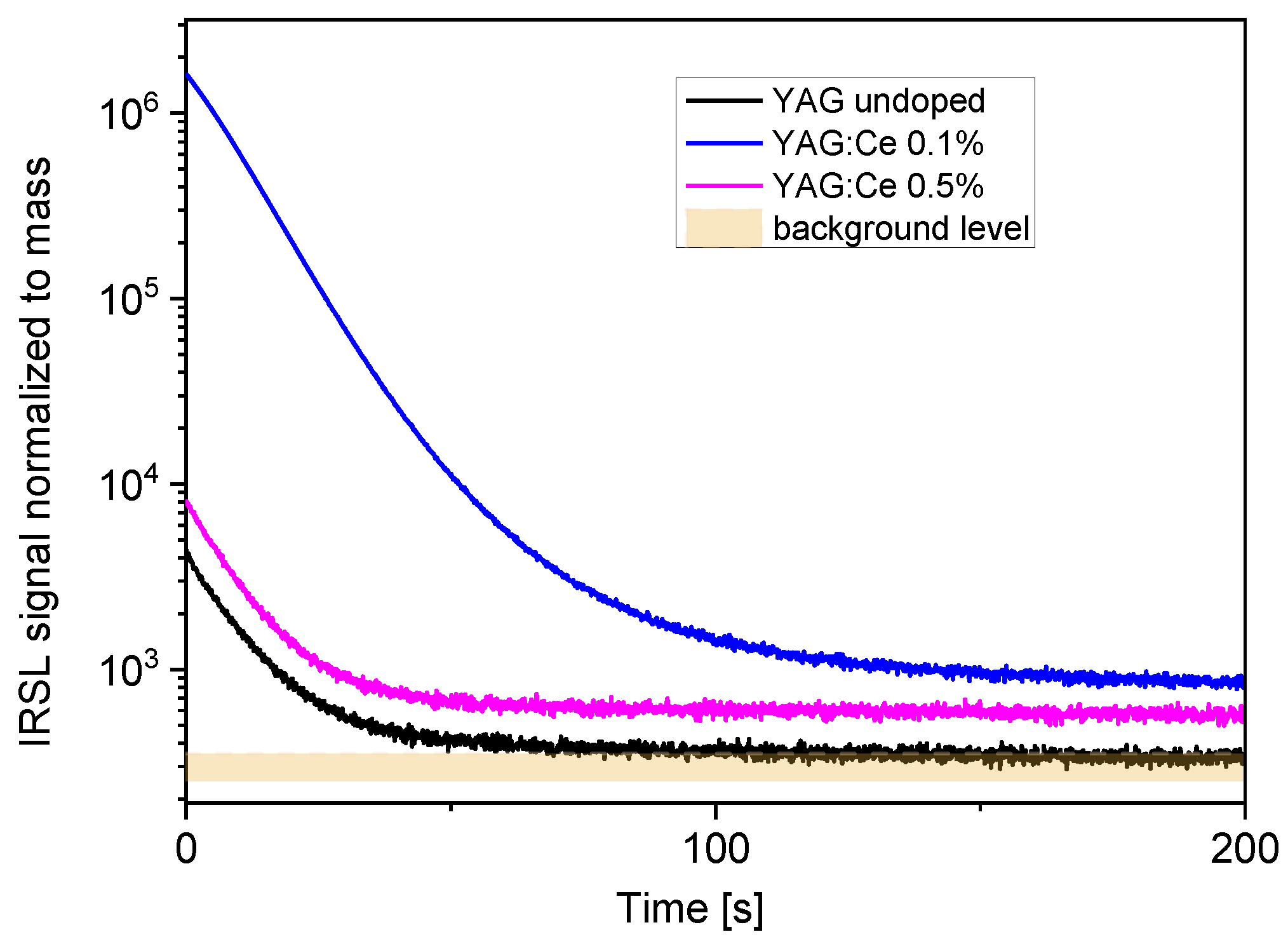
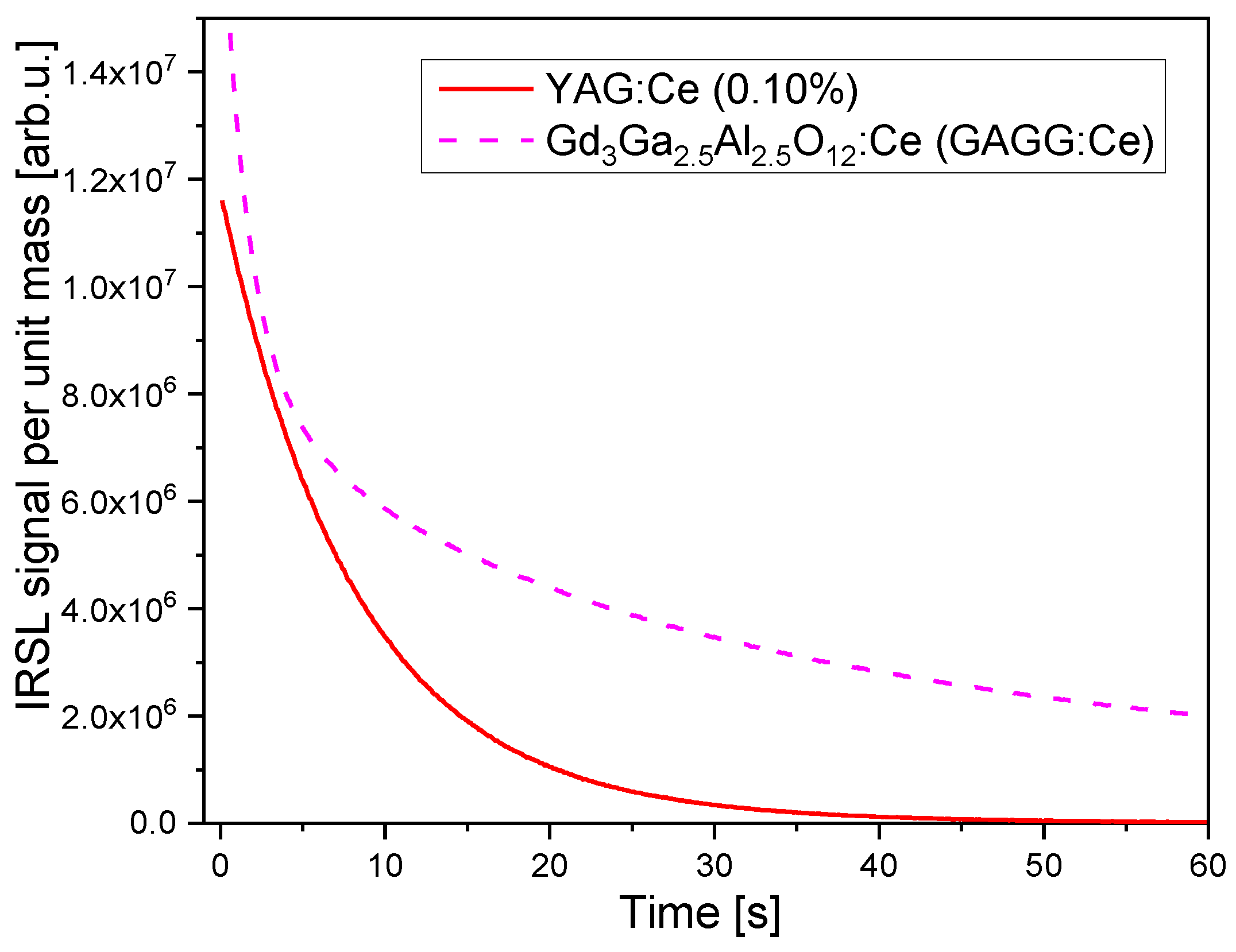


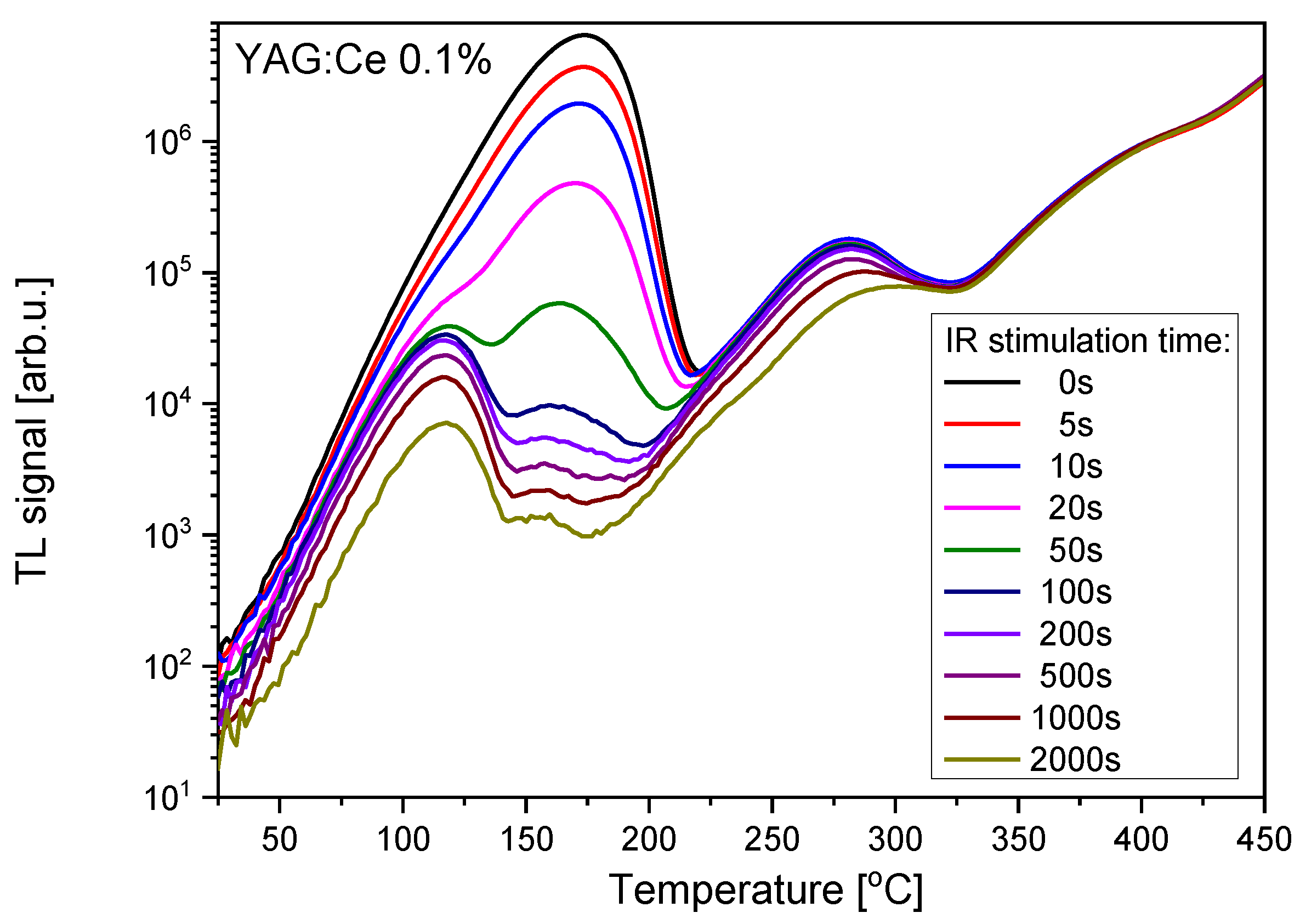
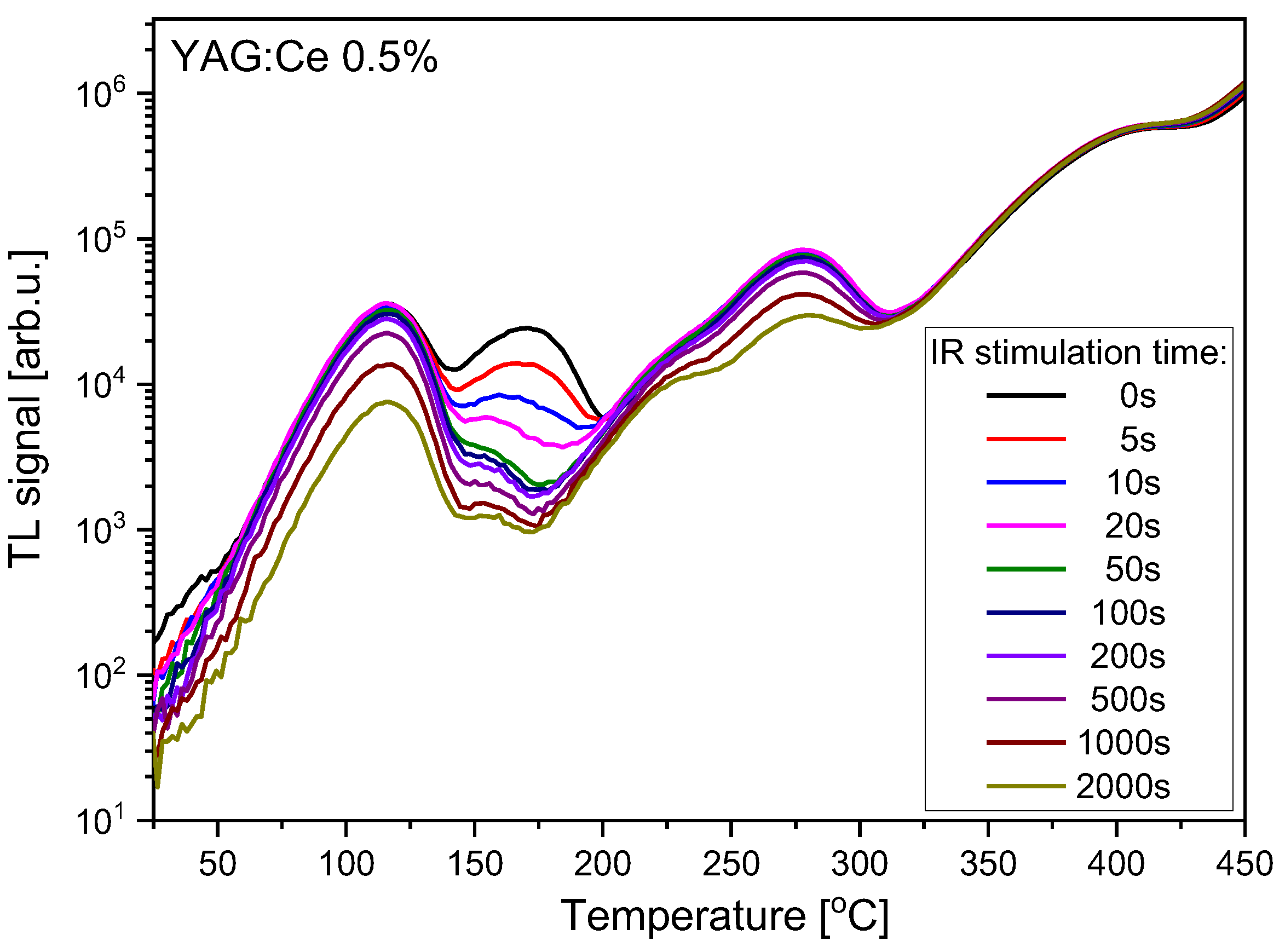
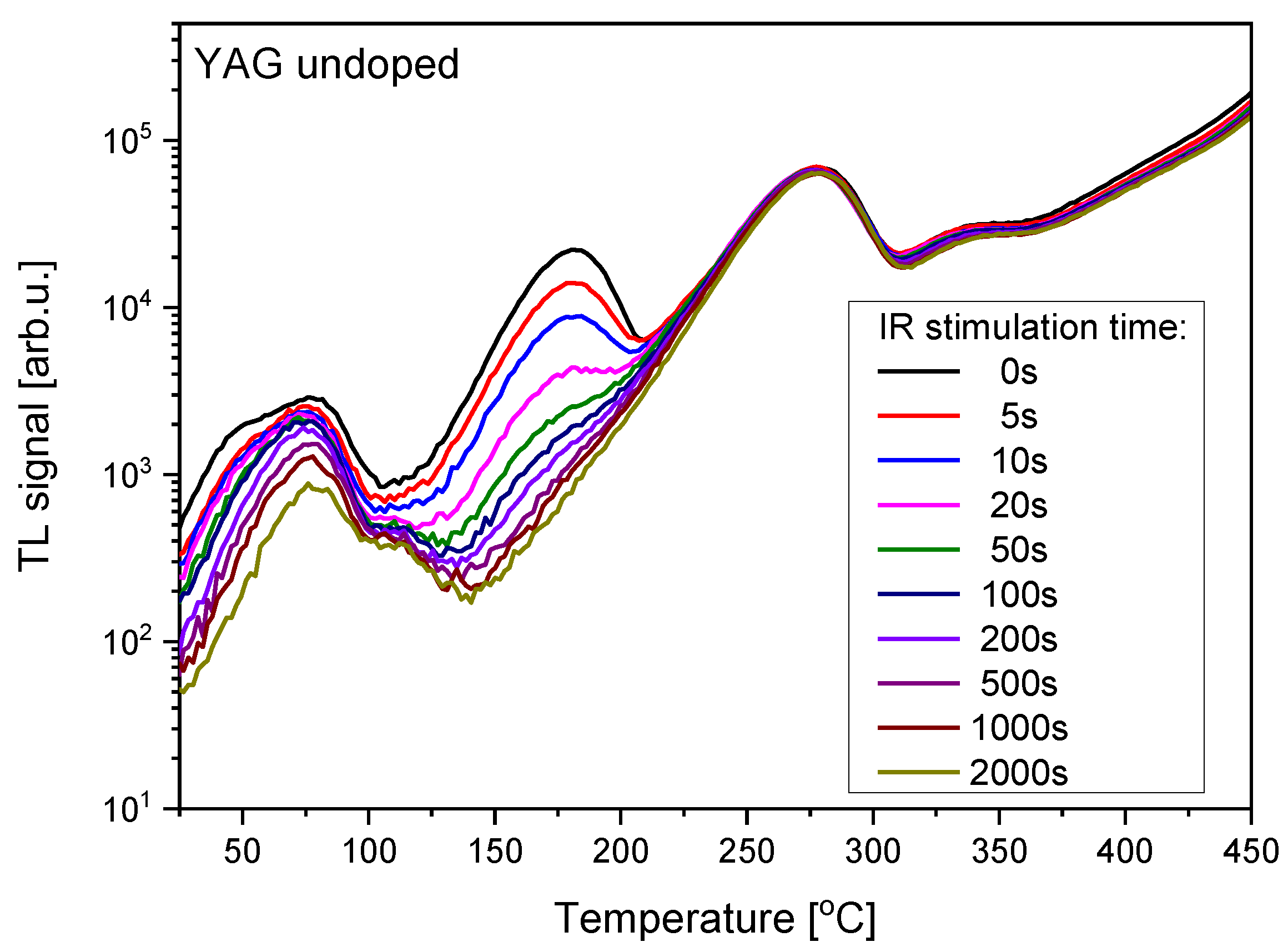
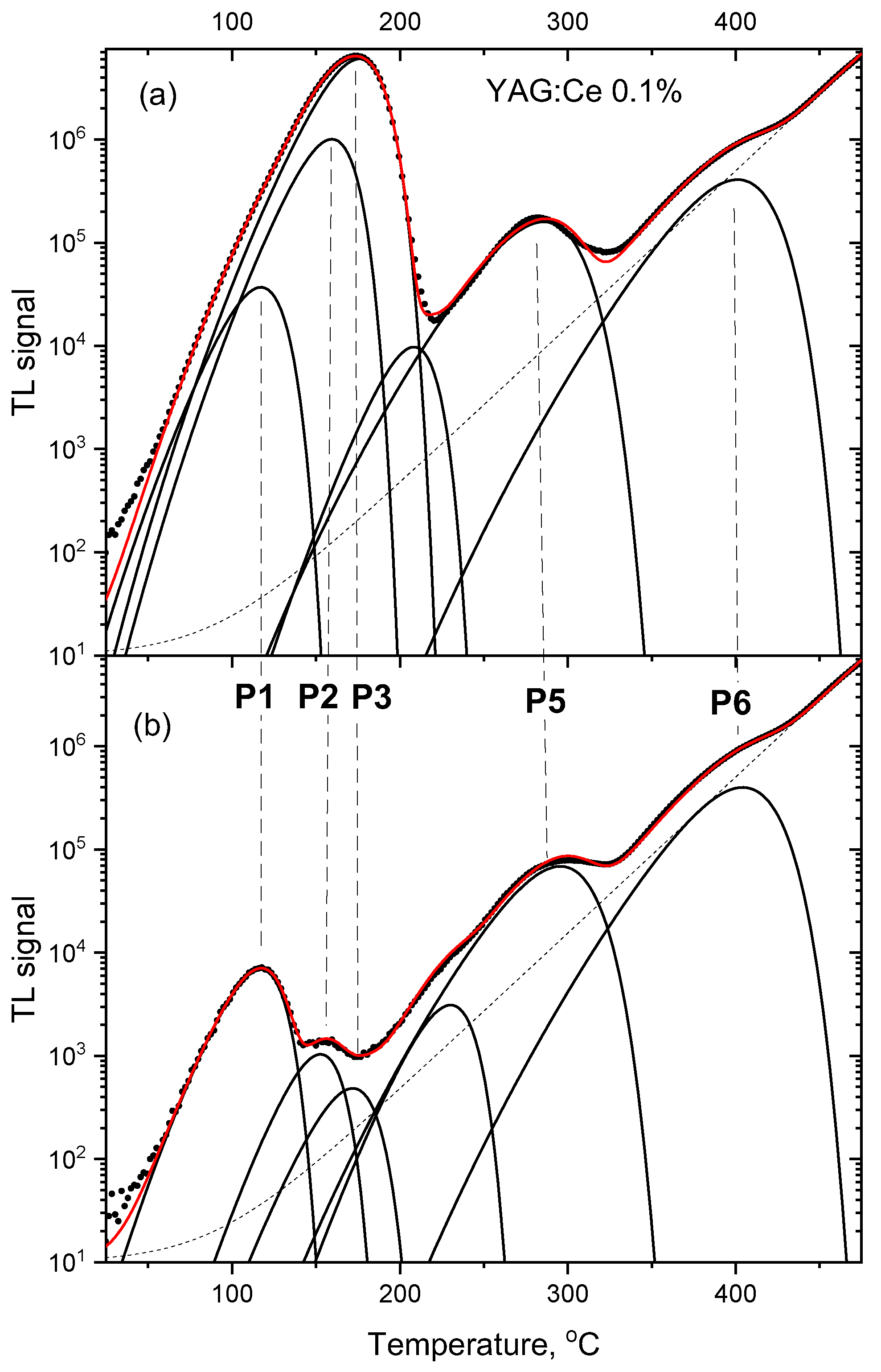

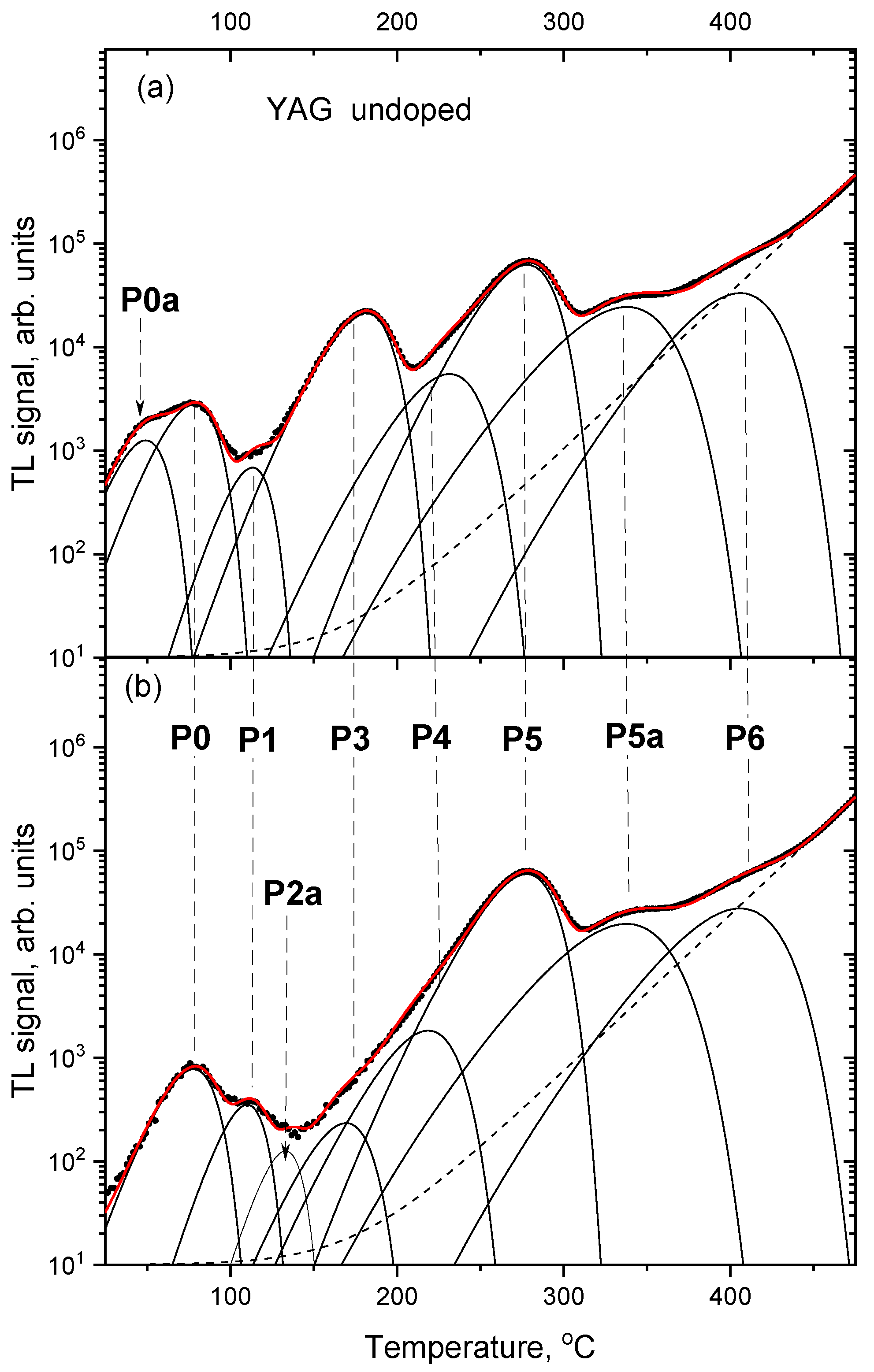
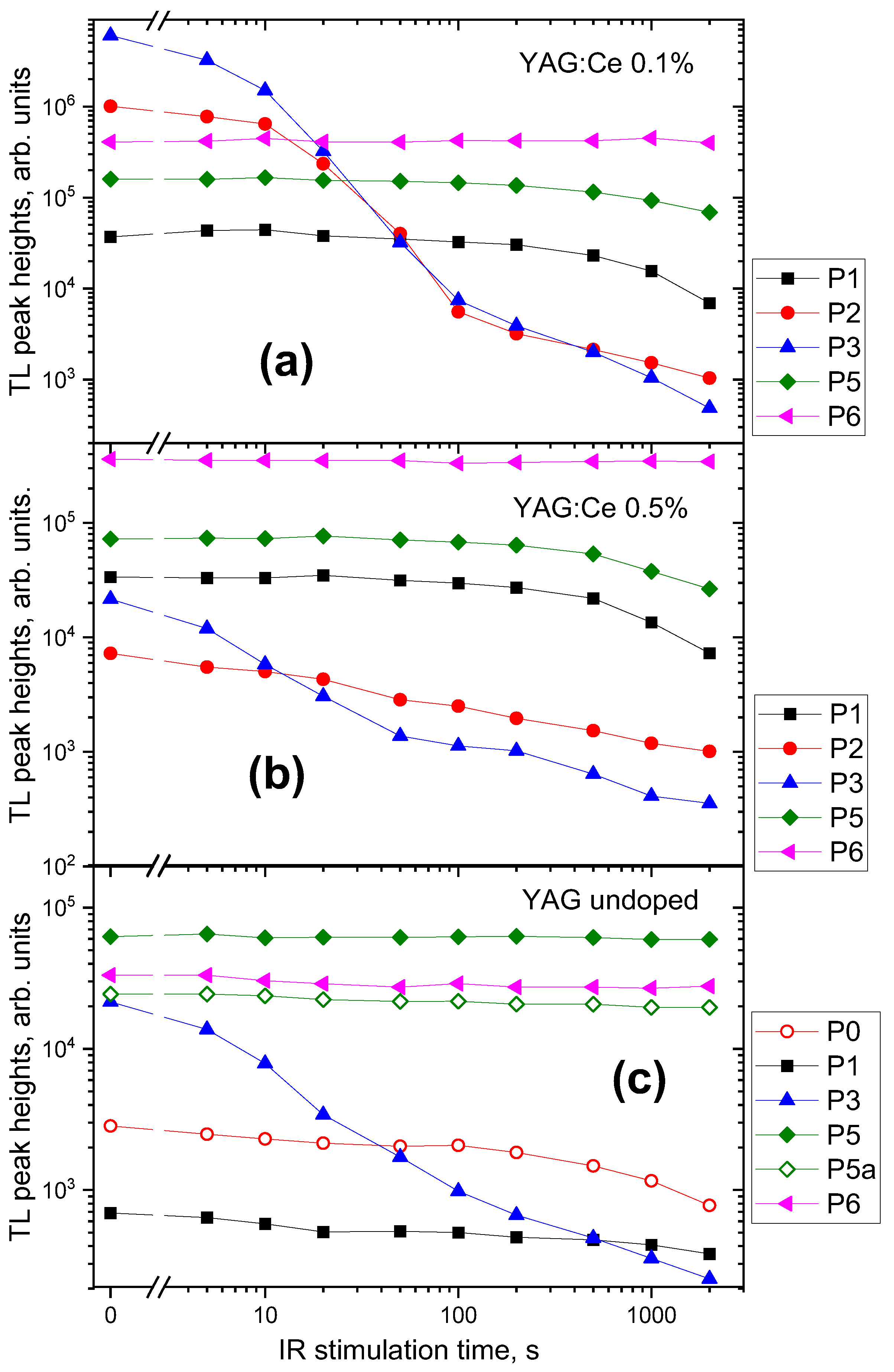
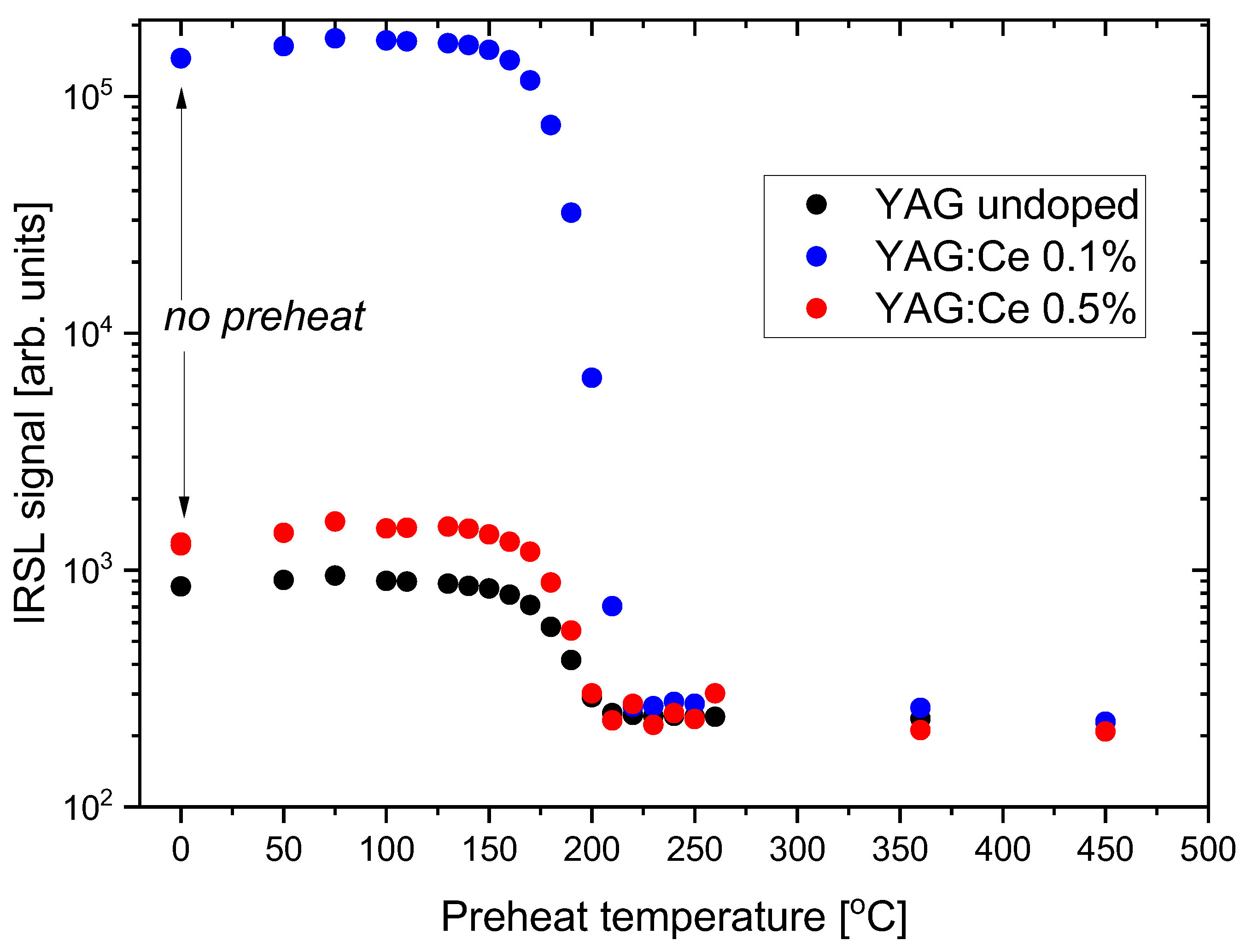
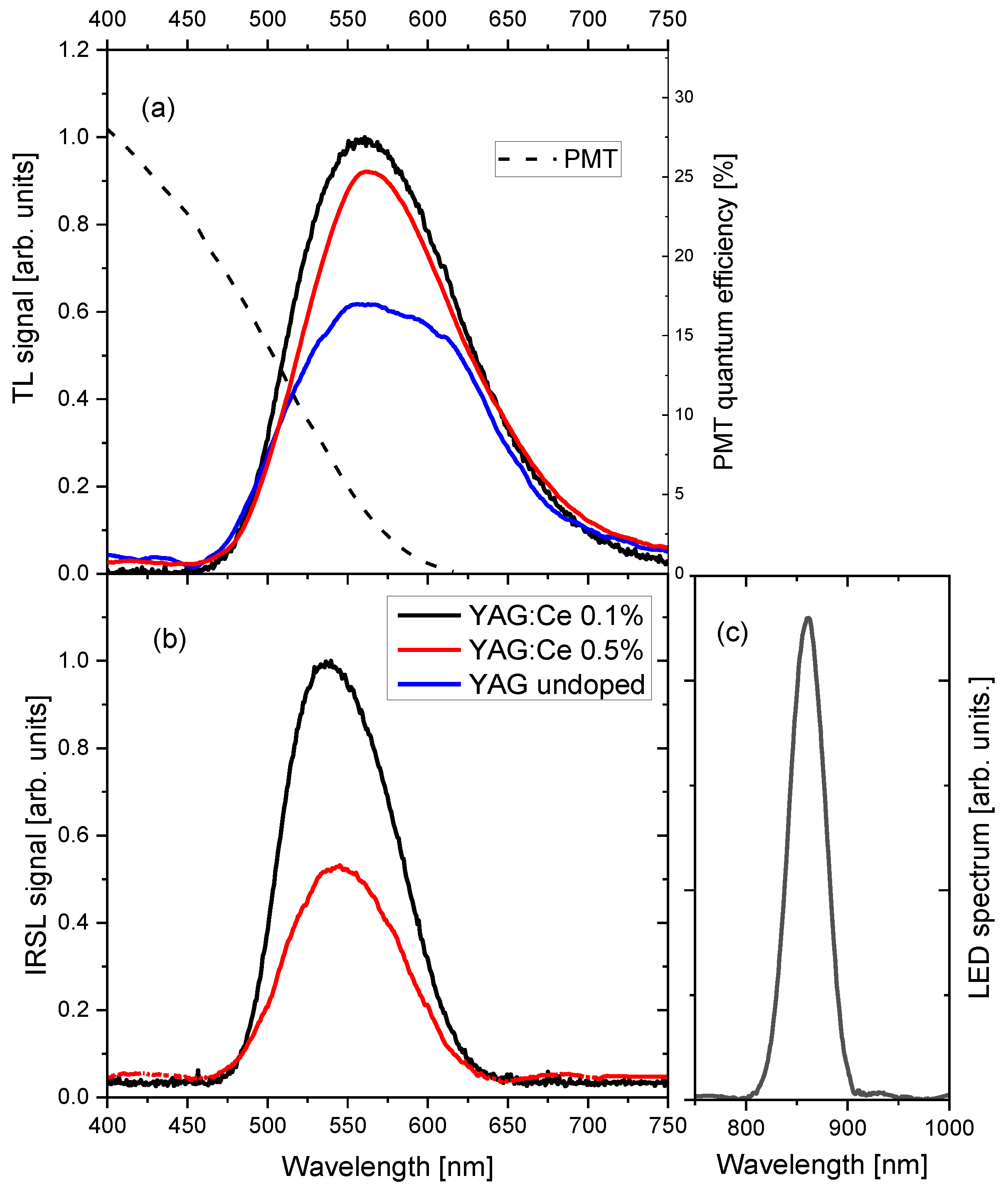
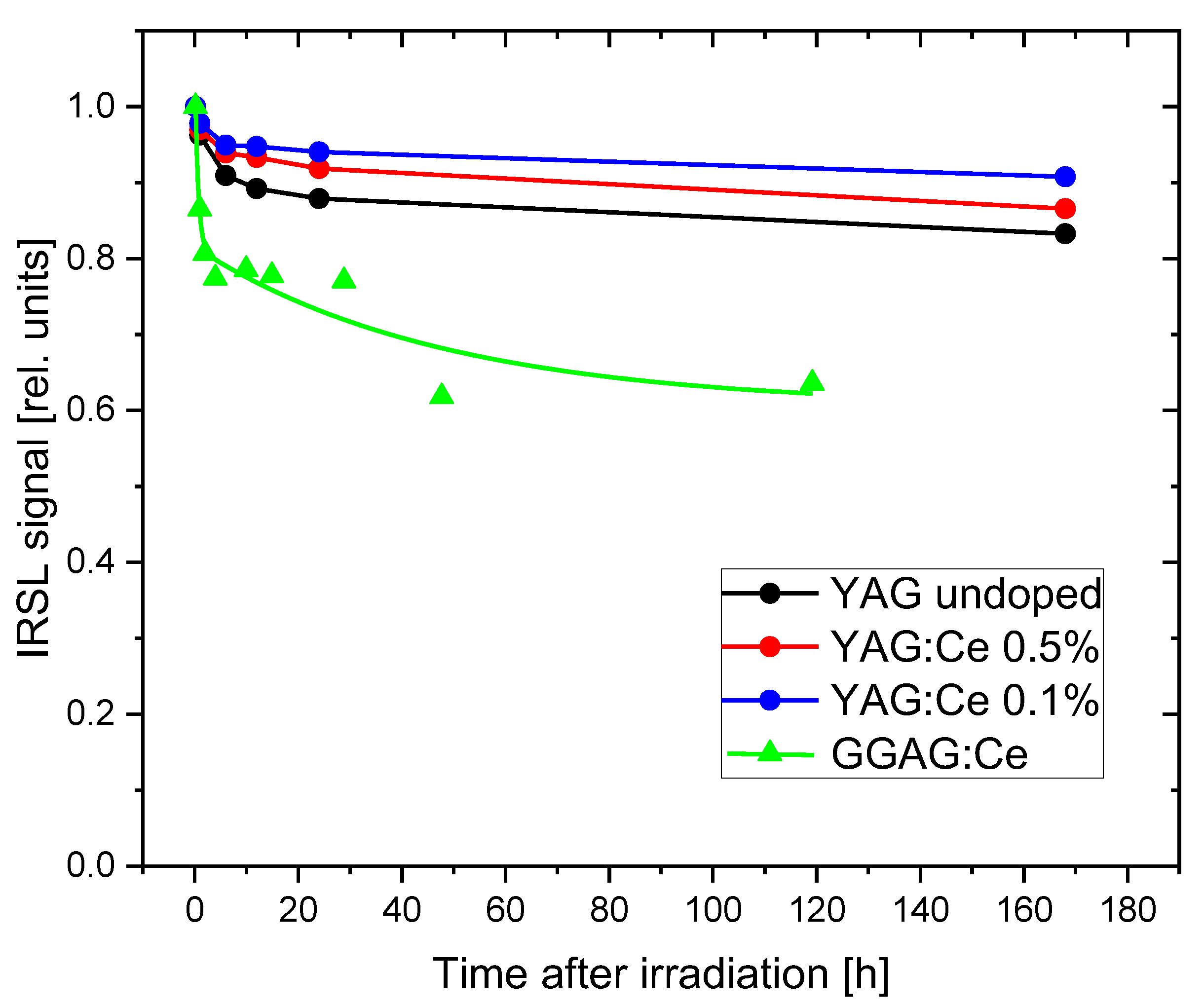
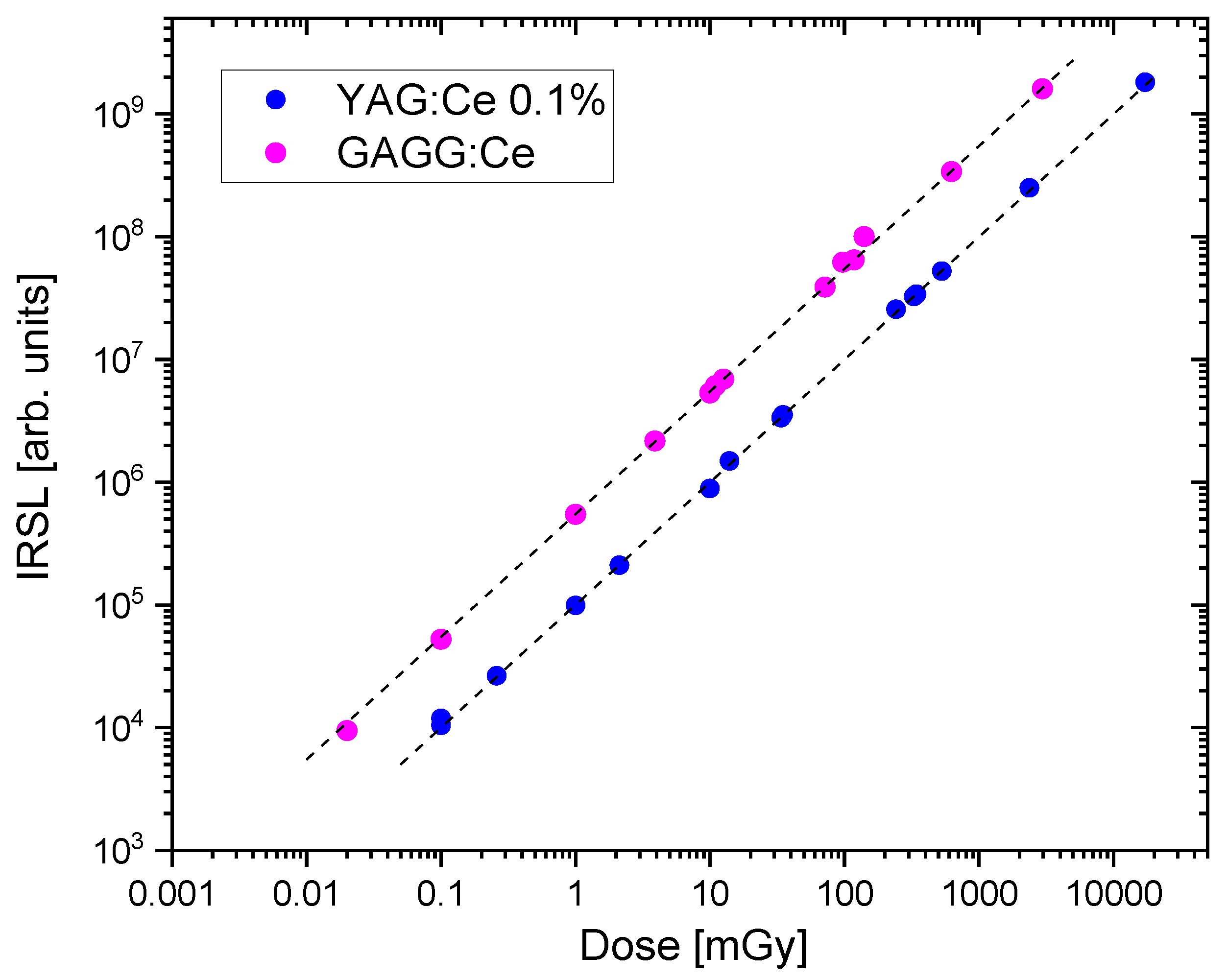
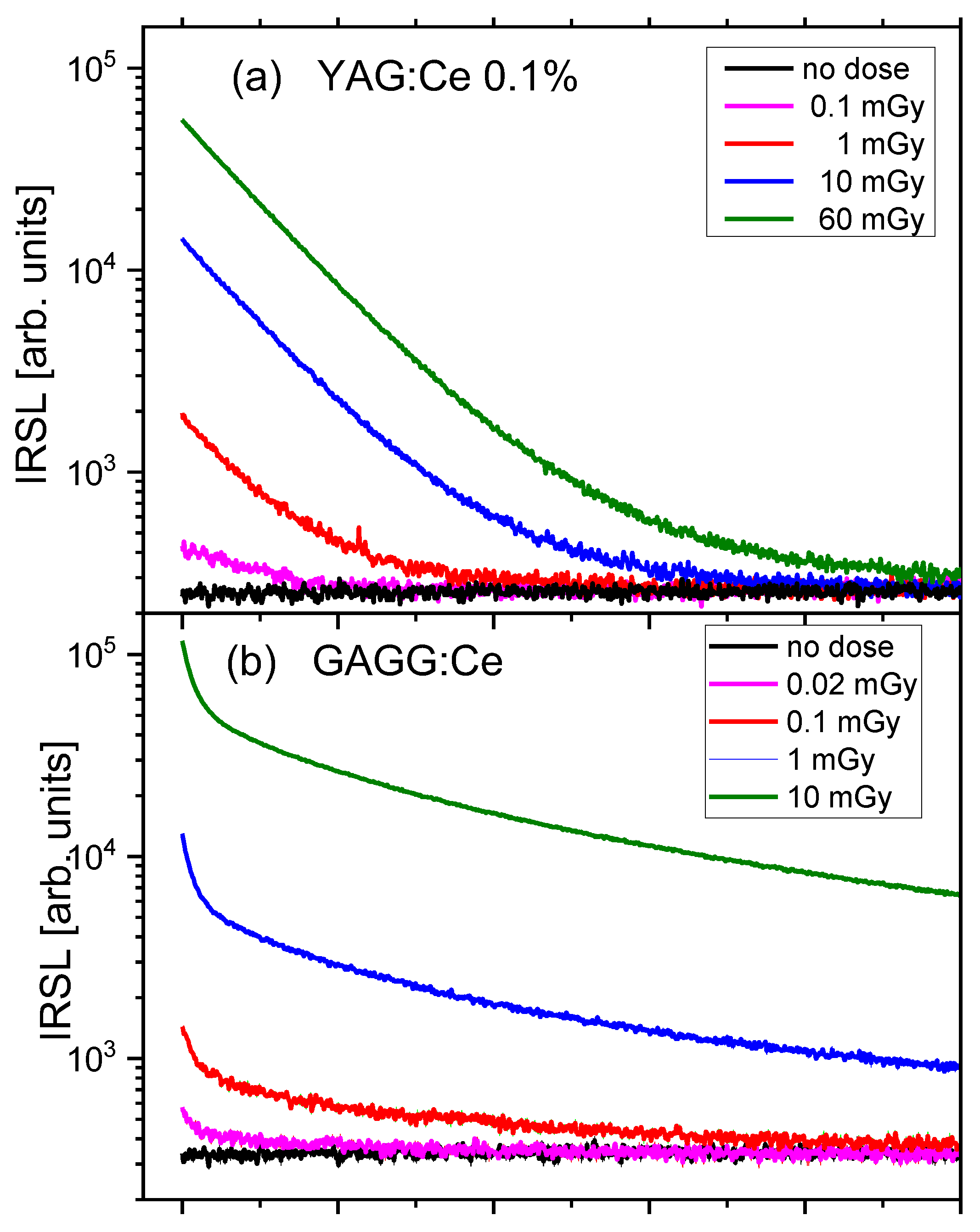
Publisher’s Note: MDPI stays neutral with regard to jurisdictional claims in published maps and institutional affiliations. |
© 2022 by the authors. Licensee MDPI, Basel, Switzerland. This article is an open access article distributed under the terms and conditions of the Creative Commons Attribution (CC BY) license (https://creativecommons.org/licenses/by/4.0/).
Share and Cite
Bilski, P.; Mrozik, A.; Gieszczyk, W.; Nizhankovskiy, S.; Zorenko, Y. Infrared Stimulated Luminescence of Ce3+ Doped YAG Crystals. Materials 2022, 15, 8288. https://doi.org/10.3390/ma15238288
Bilski P, Mrozik A, Gieszczyk W, Nizhankovskiy S, Zorenko Y. Infrared Stimulated Luminescence of Ce3+ Doped YAG Crystals. Materials. 2022; 15(23):8288. https://doi.org/10.3390/ma15238288
Chicago/Turabian StyleBilski, Paweł, Anna Mrozik, Wojciech Gieszczyk, Sergiy Nizhankovskiy, and Yuriy Zorenko. 2022. "Infrared Stimulated Luminescence of Ce3+ Doped YAG Crystals" Materials 15, no. 23: 8288. https://doi.org/10.3390/ma15238288
APA StyleBilski, P., Mrozik, A., Gieszczyk, W., Nizhankovskiy, S., & Zorenko, Y. (2022). Infrared Stimulated Luminescence of Ce3+ Doped YAG Crystals. Materials, 15(23), 8288. https://doi.org/10.3390/ma15238288






